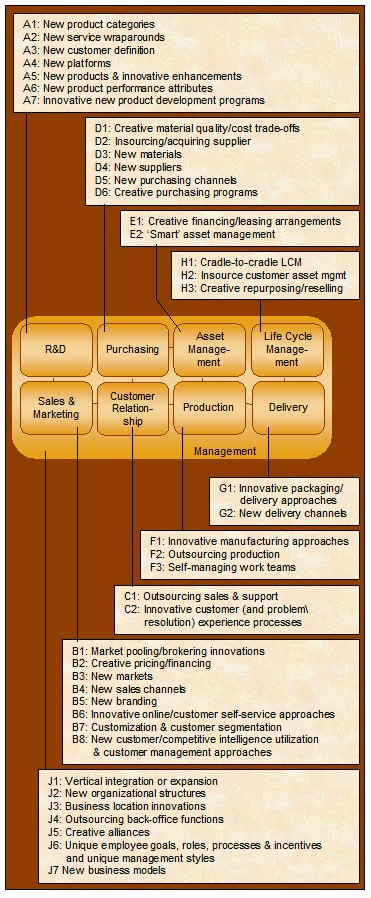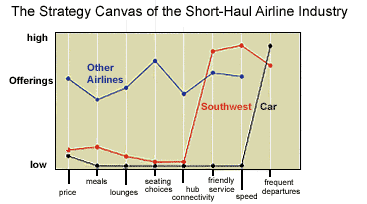 Last month I introduced the Innovation Opportunities Map, an improved version of which is shown above. We have recently been working with an entrepreneurial client using this approach to innovation, drawing on Clay Christensen’s work and also on the ideas in Blue Ocean Strategy. We are now on to the next stage of this project, and it’s turning into quite an interesting story. Our client is quite adamant that the innovations they seek to implement must be highly visible to their customers, so we have been focusing attention on the R&D, Sales & Marketing, Customer Relationship, Product/Service Delivery and Life-Cycle Management megaprocesses shown on the above chart — the five megaprocesses most directly visible to customers. In order to enhance our client’s (and our) understanding of customers’ needs and wants, we have used cultural anthropology extensively on this assignment, and our client is quite delighted with the value of having a cross-sectional team of its people systematically visiting customers, observing the use of their products, and interviewing customers about their perceptions, ideas, needs and wants. The outcome of these ‘visits’, aside from a much better understanding of their customers’ businesses, and of the joys and frustrations customers experience using our client’s (and their competitors’) products, has been a large database of Learnings and Ideas. To oversimplify a bit, here is the process they have employed to date:
The next two steps, now in progress, are:
Our client has distilled hundreds of Learnings and Ideas down into about three dozen Innovation Opportunities, and has now begun aggregating these into Innovative Offerings using the following six-part template:
The Innovation Team is now beginning the process of debating the pros and cons of the different Innovative Offerings the team members have come up with. The plan is that those Offerings that they consider most promising (using the set of criteria established in step 1) will then be evaluated by senior management to evaluate their feasibility, strategic fit etc., and will then be tested using small-scale experiments with selected customers. Only once the Offerings have passed all these hurdles will they be implemented full-scale. Some of the Offerings the team has come up with are quite awesome. They show the power of combining a deep knowledge of customer needs, ‘space’ for creativity and observation, a disciplined assessment process and the ‘wisdom of crowds’. We may just be on to the perfect recipe for entrepreneurial innovation. Stay tuned! |
Navigation
Collapsniks
Albert Bates (US)
Andrew Nikiforuk (CA)
Brutus (US)
Carolyn Baker (US)*
Catherine Ingram (US)
Chris Hedges (US)
Dahr Jamail (US)
Dean Spillane-Walker (US)*
Derrick Jensen (US)
Dougald & Paul (IE/SE)*
Erik Michaels (US)
Gail Tverberg (US)
Guy McPherson (US)
Honest Sorcerer
Janaia & Robin (US)*
Jem Bendell (UK)
Mari Werner
Michael Dowd (US)*
Nate Hagens (US)
Paul Heft (US)*
Post Carbon Inst. (US)
Resilience (US)
Richard Heinberg (US)
Robert Jensen (US)
Roy Scranton (US)
Sam Mitchell (US)
Tim Morgan (UK)
Tim Watkins (UK)
Umair Haque (UK)
William Rees (CA)
XrayMike (AU)
Radical Non-Duality
Tony Parsons
Jim Newman
Tim Cliss
Andreas Müller
Kenneth Madden
Emerson Lim
Nancy Neithercut
Rosemarijn Roes
Frank McCaughey
Clare Cherikoff
Ere Parek, Izzy Cloke, Zabi AmaniEssential Reading
Archive by Category
My Bio, Contact Info, Signature Posts
About the Author (2023)
My Circles
E-mail me
--- My Best 200 Posts, 2003-22 by category, from newest to oldest ---
Collapse Watch:
Hope — On the Balance of Probabilities
The Caste War for the Dregs
Recuperation, Accommodation, Resilience
How Do We Teach the Critical Skills
Collapse Not Apocalypse
Effective Activism
'Making Sense of the World' Reading List
Notes From the Rising Dark
What is Exponential Decay
Collapse: Slowly Then Suddenly
Slouching Towards Bethlehem
Making Sense of Who We Are
What Would Net-Zero Emissions Look Like?
Post Collapse with Michael Dowd (video)
Why Economic Collapse Will Precede Climate Collapse
Being Adaptable: A Reminder List
A Culture of Fear
What Will It Take?
A Future Without Us
Dean Walker Interview (video)
The Mushroom at the End of the World
What Would It Take To Live Sustainably?
The New Political Map (Poster)
Beyond Belief
Complexity and Collapse
Requiem for a Species
Civilization Disease
What a Desolated Earth Looks Like
If We Had a Better Story...
Giving Up on Environmentalism
The Hard Part is Finding People Who Care
Going Vegan
The Dark & Gathering Sameness of the World
The End of Philosophy
A Short History of Progress
The Boiling Frog
Our Culture / Ourselves:
A CoVid-19 Recap
What It Means to be Human
A Culture Built on Wrong Models
Understanding Conservatives
Our Unique Capacity for Hatred
Not Meant to Govern Each Other
The Humanist Trap
Credulous
Amazing What People Get Used To
My Reluctant Misanthropy
The Dawn of Everything
Species Shame
Why Misinformation Doesn't Work
The Lab-Leak Hypothesis
The Right to Die
CoVid-19: Go for Zero
Pollard's Laws
On Caste
The Process of Self-Organization
The Tragic Spread of Misinformation
A Better Way to Work
The Needs of the Moment
Ask Yourself This
What to Believe Now?
Rogue Primate
Conversation & Silence
The Language of Our Eyes
True Story
May I Ask a Question?
Cultural Acedia: When We Can No Longer Care
Useless Advice
Several Short Sentences About Learning
Why I Don't Want to Hear Your Story
A Harvest of Myths
The Qualities of a Great Story
The Trouble With Stories
A Model of Identity & Community
Not Ready to Do What's Needed
A Culture of Dependence
So What's Next
Ten Things to Do When You're Feeling Hopeless
No Use to the World Broken
Living in Another World
Does Language Restrict What We Can Think?
The Value of Conversation Manifesto Nobody Knows Anything
If I Only Had 37 Days
The Only Life We Know
A Long Way Down
No Noble Savages
Figments of Reality
Too Far Ahead
Learning From Nature
The Rogue Animal
How the World Really Works:
Making Sense of Scents
An Age of Wonder
The Truth About Ukraine
Navigating Complexity
The Supply Chain Problem
The Promise of Dialogue
Too Dumb to Take Care of Ourselves
Extinction Capitalism
Homeless
Republicans Slide Into Fascism
All the Things I Was Wrong About
Several Short Sentences About Sharks
How Change Happens
What's the Best Possible Outcome?
The Perpetual Growth Machine
We Make Zero
How Long We've Been Around (graphic)
If You Wanted to Sabotage the Elections
Collective Intelligence & Complexity
Ten Things I Wish I'd Learned Earlier
The Problem With Systems
Against Hope (Video)
The Admission of Necessary Ignorance
Several Short Sentences About Jellyfish
Loren Eiseley, in Verse
A Synopsis of 'Finding the Sweet Spot'
Learning from Indigenous Cultures
The Gift Economy
The Job of the Media
The Wal-Mart Dilemma
The Illusion of the Separate Self, and Free Will:
No Free Will, No Freedom
The Other Side of 'No Me'
This Body Takes Me For a Walk
The Only One Who Really Knew Me
No Free Will — Fightin' Words
The Paradox of the Self
A Radical Non-Duality FAQ
What We Think We Know
Bark Bark Bark Bark Bark Bark Bark
Healing From Ourselves
The Entanglement Hypothesis
Nothing Needs to Happen
Nothing to Say About This
What I Wanted to Believe
A Continuous Reassemblage of Meaning
No Choice But to Misbehave
What's Apparently Happening
A Different Kind of Animal
Happy Now?
This Creature
Did Early Humans Have Selves?
Nothing On Offer Here
Even Simpler and More Hopeless Than That
Glimpses
How Our Bodies Sense the World
Fragments
What Happens in Vagus
We Have No Choice
Never Comfortable in the Skin of Self
Letting Go of the Story of Me
All There Is, Is This
A Theory of No Mind
Creative Works:
Mindful Wanderings (Reflections) (Archive)
A Prayer to No One
Frogs' Hollow (Short Story)
We Do What We Do (Poem)
Negative Assertions (Poem)
Reminder (Short Story)
A Canadian Sorry (Satire)
Under No Illusions (Short Story)
The Ever-Stranger (Poem)
The Fortune Teller (Short Story)
Non-Duality Dude (Play)
Your Self: An Owner's Manual (Satire)
All the Things I Thought I Knew (Short Story)
On the Shoulders of Giants (Short Story)
Improv (Poem)
Calling the Cage Freedom (Short Story)
Rune (Poem)
Only This (Poem)
The Other Extinction (Short Story)
Invisible (Poem)
Disruption (Short Story)
A Thought-Less Experiment (Poem)
Speaking Grosbeak (Short Story)
The Only Way There (Short Story)
The Wild Man (Short Story)
Flywheel (Short Story)
The Opposite of Presence (Satire)
How to Make Love Last (Poem)
The Horses' Bodies (Poem)
Enough (Lament)
Distracted (Short Story)
Worse, Still (Poem)
Conjurer (Satire)
A Conversation (Short Story)
Farewell to Albion (Poem)
My Other Sites






Dave, this post has really excited me. It describes what I have lately been looking at quite intensively: The application of “design methods” and “design thinking” to business innovation. Design thinking is characterized by things like focus on the customer (using e.g. “cultural anthropology”), Ideation and Prototyping, Finding Alternatives, Wicked Problems, Collaboration, etc. A nice overview is given by Ralf Beuker at:http://www.designthinkinginstitute.com/2005/10/18/swarms-pipelines-design-thinking-and-heraclitus/I find your post interesting because it combines the ideas of design thinking with more traditional business concepts like the strategy canvas. As “business people” we can learn a lot from designers who really practice in-depth understanding of customers. I have seen this exemplified at Suunto.com, a watchmaker, that sends teams of anthropologists to live with their customers, such as the sailing community…
Great post Dave. The mere fact that there is focus on a methodology behind managing innovation at your client is a great start! Good luck with the outcomes. Also, on the point of involving customers, great article on FT.com (http://news.ft.com/cms/s/dcaa9ca4-28d8-11da-8a5e-00000e2511c8,dwp_uuid=863bb51c-1f76-11da-853a-00000e2511c8.html) describes how far some progressive companies are taking this concept. To be honest though, it is not new at all. I based my masters thesis on this 10 years ago and proved that companies that involved customers more in new product development were more likely to deliver innovative and successful products that customers were more likely to purchase. Several years later, the The Co-Creation Connection written by C.K. Prahalad and Venkatram Ramaswamy really advanced the thinking in this area.
Thanks guys, for the kind words and the useful references.